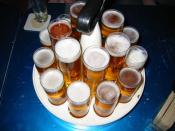What Kind of a Disease is Alcoholism?
"According to the National Institute on Alcohol Abuse and Alcoholism (NIAAA), about 17 million people - more than 10 percent of the adult population - drink too much or are unable to control their drinking"("Alcohol".) In addition, about 53 percent of men and women in the United States report that one or more of their close relatives have a drinking problem ("FQA - Alcohol"). The percentage increases as the alcoholics increase every year. Alcoholism, which is also known as alcohol dependence syndrome, is a widespread problem, which can happen after a month or years of drinking. Alcoholism is characterized by craving, loss of control, physical dependence, and tolerance. It is a disease that gets worse the more the person keeps drinking. Without treatment by trained people, it can destroy a person's mental and physical health and lead to death. ("Alcoholism: Getting the Facts").
"Alcoholism is a disease of the mind and body similar to other diseases like cancer" (Hudman). The progression of the disease is so slight and usually takes place over such an extended period of time like after months or years of drinking. Because of the period of time it takes, the alcoholic loses the point that he/she loses control over himself/herself. Just like cancer, alcoholism is a disease that gets worse the more the person keeps drinking in a period of time. As the alcoholic increases the amount of alcohol, the symptoms become more obvious. According to NIAAA, the symptoms are:
* Craving: A strong need, or compulsion, to drink.
* Loss of control: The inability to limit one's drinking on any given occasion.
* Physical dependence: Withdrawal symptoms, such as nausea, sweating, shakiness, and anxiety, occur when alcohol use is stopped after a period of heavy drinking.
* Tolerance: The need to drink greater amounts of alcohol in order to "get high" ("FQA - Alcohol").
According to Goodwin, most of the alcoholics drink alcohol because it makes them feel good and it helps them forget their problems. Furthermore, they like to drink, but after a period of time the like turns out a need. The amount of four on men and five on women seems enough to get drunk at the beginning, but then that amount increases and even ten drinks become insufficient. When this happens alcoholic starts losing control over his body and mind. That is the time that alcoholic looks to life nothing but one more drink (33). "The alcoholic thinks about alcohol from morning till night, and at night if not too drunk, dreams about alcohol" (Goodwin 35). He starts thinking of the possibilities anywhere anytime of the day and night. Then, the alcoholic makes up good reasons to drink. When alcoholics think it is being a problem, they think they can stop anytime, but they never want to! So, they make up reasons that make the day special, so that they can drink more and more.
An individual may drink to get over difficult feelings or emotions that are caused by an illness that can be treated. One may also drink to lessen feelings of guilt, loneliness, confusion, to calm nerves or forget problems, but then end up needing alcohol to feel normal. At that time alcoholics' inhibitions become lower and judgment becomes weak. This leads alcoholic into dangerous choices.
Once people lose control over drinking, they need help to stop drinking. Alcoholism is a disease in which people drink alcohol even though drinking hurts their life. Population survey shows that about 70 percent of adults in the USA drink. About 12 percent of Americans drink heavily almost daily and intoxicated several times a month. 9 percent have problems from drinking, mostly minor; another 9 percent have had problems in the past (Goodwin 34). People with alcoholism often find that they have problems with people close to them, school, work, or other parts of their lives ("Family in Crisis" 3).
Many people wonder: Why can some individuals use alcohol without problems, while others are utterly unable to control their drinking? Recent research supported by NIAAA has demonstrated that for many people, a vulnerability to alcoholism is genetically inherited. Environmental influences can foster genes and motivate a person to drink. Children in families with alcoholic members are at higher risk for alcoholism. This disease tends to run in families ("Diseases & Conditions").
Alcoholism has more to do with those who have uncontrollable drinking; then those who has been drinking for a long time, or those who are heavy drinkers. People who have uncontrollable drinking can not just quit by saying "I Quit". Those people need special treatment rather then the just the "willpower" ("Programs"). They can only be recovered with a treatment assisted by trained people. While the alcoholic is in treatment the severity of the problem and the willingness of the patient will determine the extent of treatment he or she will undergo ("Programs").
Unfortunately, there is no cure for alcoholism. We have to recognize and accept that alcoholism is a chronic medical disease like diabetes or asthma, worsen by social conditions. Only recovery is possible for the people who are alcoholic. This happens after treatment in a period of time, depending on how serious alcoholic the alcoholic is. People with alcoholism who have completely stopped drinking are called "recovering alcoholics"("Programs"). Recovering alcoholics can lead healthy, happy, productive lives, but that never means people who recovered are 100 percent free from alcohol. An alcoholic, who is recovered from alcohol, can turn back to the previous condition anytime if that person breaks the barrier on drinking.
Alcoholism is an inherited, inevitable disease that makes progress over a period of time. While the cure is not possible for alcoholism, treatment is always available and people could be recovered from alcohol as long as they want to recover from it. Going into treatment with a trained person always gives good result on recovery and the recovery time depends on how much the addicted wants to overcome.
Works Cited
"Alcohol." Great Falls Tribune. (February 21, 1999)
difference/greatfalls/pages/part2/problem.html.> ( April 2, 2002)
"Alcoholism: Getting the Facts." National Institute on Alcohol Abuse and Alcoholism (NIAAA). (November 13, 2001) . ( April 2, 2002)
"Diseases & Conditions - Alcohol Abuse and Alcoholism." MedicineNet, Inc. (April 1,
2002)
=8709&page=1> (April 2, 2002)
"A Family in Crisis." About.com. (2002) . (March 22, 2002)
"Frequently Asked Question-Alcohol." National Institute on Alcohol Abuse and Alcoholism (NIAAA). (November 2001)
( April 2, 2002)
Goodwin, Donald W. Alcoholism, The Facts. 3rd ed. New York: Oxford
University Press Inc, 2000.
Hudman, Jennifer. "Following ER." JHSPH Office of Public Affairs. ( March 28, 2002)
"Programs." The American Council on Alcoholism (ACA). ( April 2, 2002)



VERY GOOD, NICE REFsources
Coming from a family of ETOH abuse, I really was scared that I my be prone to this Dz process, The stats in this essay are very well placed to back the statements held within. I hope this opens eyes to the P/F ETOH abuse.
PSA, Remember Don't drink & Drive! Be safe.
8 out of 8 people found this comment useful.